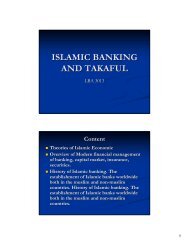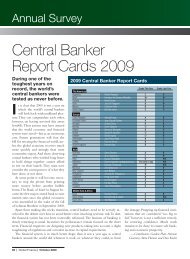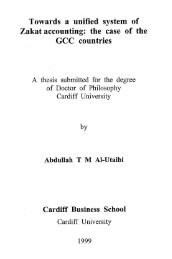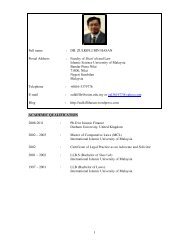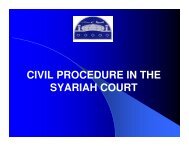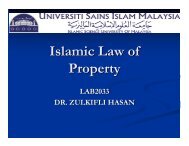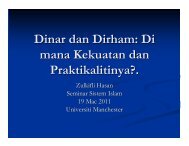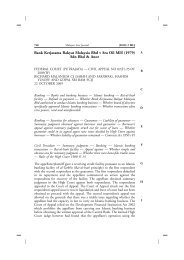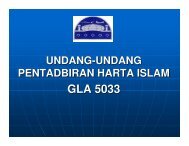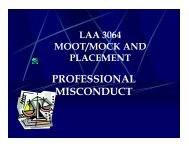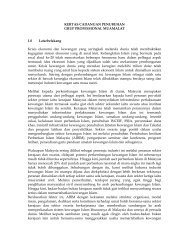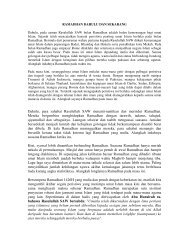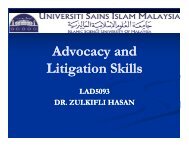guidelines for shariah moot
guidelines for shariah moot
guidelines for shariah moot
Create successful ePaper yourself
Turn your PDF publications into a flip-book with our unique Google optimized e-Paper software.
RULES AND GUIDELINESFOR SYARIAH MOOTMOOT MOCK, PLACEMENT (LAA 3064)FACULTY SYARIAH AND LAWISLAMIC UNIVERSITY COLLEGE OFMALAYSIA
2. SpeakingIt is a common mistake to read too quickly from a prepared brief. Make submissions, bydescribing the basis of your legal argument, and introduce points in support briefly,showing how each in turn supports your submission. Look at the judge; you can often tellif your arguments are going well, and if not, you may need to add more explanation. Dealwith the authorities on the other side's list.Avoid saying “ I think or in my opinion”. Use words “I submit or it is my contention”. Ifthe judge disagreeing with you use words “ With respect, Yang Arif, the thrust of myargument is that…”.3. Court EtiquetteMooting is modeled on court procedure. Moots are usually appeal hearings be<strong>for</strong>e theCourt of Appeal. Address the judge directly as: "Yang Arif". Your fellow counsel is "Mylearned counsel". Your opponents are: "My learned friends". When referring to realjudges by name make sure you get their names correct. For example “Datuk or Dato’.4. PreparationThe <strong>moot</strong> sheet will state the facts, which must be accepted. You cannot argue thatfindings of fact in the lower court were wrong. A <strong>moot</strong> is an argument on points of lawonly. The <strong>moot</strong> sheet will also state the grounds of appeal. You are bound by them, eventhough you may feel you could have drafted them better. What submissions you are ableto make may depend on the case.a) Documents and authoritiesBundle of documents and authorities will identify the day on which arguments and listsof authorities have to be exchanged. The documents will support your contention andauthorities will strengthen your case. It should cite the main authorities relied upon.
) Exchange of documents and authoritiesTeams are required to provide documents and authorities <strong>for</strong> their opponents and thejudge in advance of the <strong>moot</strong> on the date specified.c) Providing authorities <strong>for</strong> the courtMooters are responsible <strong>for</strong> following the Court’s procedures. Bundle of documents andauthorities should be prepared in good and in order to enable the judge to find theauthorities and documents easily. Failure to comply with this rule will affect yoursubmission.5. Answering QuestionWhen you are interrupted and questioned by the judge - as you will be - listen carefully tothe question, and attempt to provide the most effective answer you can. This is so even ifyou were about to come to that point in your argument later.With permission of the judge, you may consult your learned counsel. If you have noanswer, don't flannel. Admit the strength of the objection, and thank the judge <strong>for</strong> makingit: "I'm obliged to Yang Arif". Either move on, or bring your submissions to a close.6. Use Of AuthoritiesIn citing al-Quran, you must identify which surah, verse and tafsir that you refer. In citingal-hadith you have to mention its reference. Highlight the important points.When citing authority, you must identify the court deciding the case, and its relativeauthority in the <strong>moot</strong> court (binding or persuasive). If you are quoting from a judgment,say whether it <strong>for</strong>ms part of the ratio decidendi of the case or is obiter dicta. Make sureyou know which judges, if any, dissented. Incomplete quotation, especially if it distortsthe judge's reasoning, will result in deduction of marks. If you want to cite the words of ajudge you must cite the case in which those words were reported, not a later one wherethose words may have been quoted by another judge.
Where relevant, you should cite statutes, and other authorities e.g. text books, MalaysianLegal System, written by Prof Ahmad Ibrahim page 8 or Minhaj al-Talibin written by Al-Nawawi page 9. Only recognized references will be acceptable.Cite the most authoritative report. Prefer reports produced by Jurnal Hukm, MLJ andCLJ. Refering to a report in a speech. What in writing would be Pendakwa Syarie v.Agus Sali [2005] 1 JH 16 in speech becomes: "In the case of the Pendakwa Syarie andAgus Sali reported in the first volume of the Jurnal Hukm <strong>for</strong> two thousand five at pagesixteen". Note you say 'and', although you write 'v'. In speech, a criminal case onindictment is either: "In PP against Amri ". You never say 'v' or 'versus' or 'R', or 'Reg' or'Regina'.Citing electronic reports. Subject to what is said above about selecting the bestauthorities, there is no rule excluding cases reported only electronically. "In the case ofthe Pendakwa Syarie and Agus Sali reported in the first volume of the Jurnal Hukm <strong>for</strong>two thousand five ". Pinpoint references are to paragraph numbers.
RULES OF THE SYARIAH MOOT1. The <strong>moot</strong> problem will be handed out to the participating teams at least sevendays be<strong>for</strong>e the <strong>moot</strong>.2. Each team may use only recognized authorities. For example reference made tosyiah’s view will be extremely rejected.3. Each team must prepare bundle of documents and authorities (includingdocuments, references to al-Quran, al-hadith, articles, statutes, textbooks to beused).4. Students are required to prepare written submissions and submit it to the judgeafter the <strong>moot</strong>ing.5. Each student will be allowed 5-7 minutes to present his or her arguments (Total of30-35 minutes per team). In addition, representative <strong>for</strong> the appellant orrespondent will be allowed a 3-5 minutes right to reply if he or she wishes.6. On the day of the <strong>moot</strong>ing, each team will be responsible <strong>for</strong> his own authorities.They must follow the standard procedure and must provide the judge and theopposition bundle of documents and authorities on the date of the <strong>moot</strong>ing.7. Court dress must be worn during each contest by the participating teams. Rob canbe taken be<strong>for</strong>e 10 minutes of the <strong>moot</strong>. Male counsel must wear black songkokand female counsel shall wear a white scarf.8. The competition is based as far as possible and as time will allow on a pointssystem. Points are awarded <strong>for</strong> presentation and clarity of argument, ability toanswer questions, use of authorities and courtroom manner.9. The <strong>moot</strong> are open to interested viewers but the court’s rules have to be followed.10. All <strong>moot</strong>s are to be held in the <strong>moot</strong> court located at ground floor of FacultySyariah and Law, KUIM.11. Any student who is unable to attend at the time specified should advise the judgeat the earliest possible time. Otherwise no mark will be given. The judge reservesthe right to penalize the latecomers at his discretion.12. Any of the above rules may be amended at any time at the discretion of the judgeof Moot.



